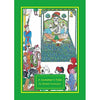- No products in the cart.
INSTANT DELIVERY
Shipping & Returns
 A Revolutionary Life
Rs. 250.00
A Revolutionary Life
Rs. 250.00
 A Summer's Tale
Rs. 314.00
A Summer's Tale
Rs. 314.00
 A Word Thrice Uttered
Rs. 350.00
A Word Thrice Uttered
Rs. 350.00
 Aashiqana Lucknow Diary
Rs. 450.00
Aashiqana Lucknow Diary
Rs. 450.00
Shipping & Returns
Find best artisans
In your need
For All Your Questions
Based on a popular romantic folktale of Laurik and Chanda, the story was well-known in the samas (gatherings) of the Chistiyya Sufi order during the 14th century. The Chandayana was later circulated via manuscripts, of which only 5 survive today in incomplete and damaged conditions. These manuscripts serve as rich examples of vernacular painting styles that developed during the Sultanate period. Reading through this one story, exposes us to a rich world of pre-Mughal Sultanate painting traditions of India presented here at a scale and volume that is unmatched in publications in the field. Besides being a fascinating book, it is a foundational book in Hindi literature, loved by every student of the subject. It also addresses early Hindu-Muslim interactions and traces the way an oral folk ballad became codified as a Sufi sermon, finally finding new life in elaborate illustrated manuscripts. The translator of the volume, Richard J. Cohen, and essayist Vivek Gupta will both be in India at the time of the Sanatkala Festival. Naman Ahuja, who is based in Delhi can also be there. We truly believe a conversation around this fascinating book would be of interest to a wide cross-section of the audience.
Based on a popular romantic folktale of Laurik and Chanda, the story was well-known in the samas (gatherings) of the Chistiyya Sufi order during the 14th century. The Chandayana was later circulated via manuscripts, of which only 5 survive today in incomplete and damaged conditions. These manuscripts serve as rich examples of vernacular painting styles that developed during the Sultanate period. Reading through this one story, exposes us to a rich world of pre-Mughal Sultanate painting traditions of India presented here at a scale and volume that is unmatched in publications in the field. Besides being a fascinating book, it is a foundational book in Hindi literature, loved by every student of the subject. It also addresses early Hindu-Muslim interactions and traces the way an oral folk ballad became codified as a Sufi sermon, finally finding new life in elaborate illustrated manuscripts. The translator of the volume, Richard J. Cohen, and essayist Vivek Gupta will both be in India at the time of the Sanatkala Festival. Naman Ahuja, who is based in Delhi can also be there. We truly believe a conversation around this fascinating book would be of interest to a wide cross-section of the audience.
| Product | Price | Quantity | Options | |||||
|---|---|---|---|---|---|---|---|---|
| Features |
| Availability: |
| Price |
| Options |
| Actions |
